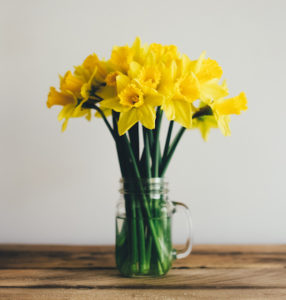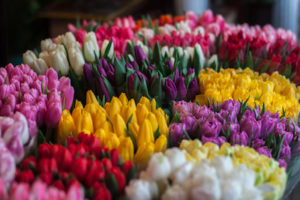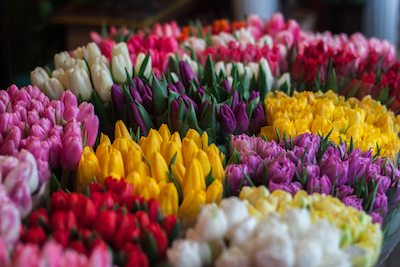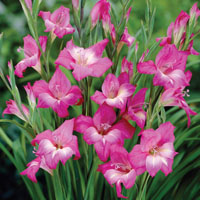 More often than not, this question is asked in relation to a wedding. And I can understand why – growing your own tulips, lilies or other bulbs would save money and look fantastic in bouquets or in the background of photos.
More often than not, this question is asked in relation to a wedding. And I can understand why – growing your own tulips, lilies or other bulbs would save money and look fantastic in bouquets or in the background of photos.
Unfortunately, the timing of bulbs flowering is heavily reliant on nature. And, as Cyclone’s Cook and Debbie have recently reminded us, nature and weather can be fickle and hard to predict in advance.
So, the question of timing flowering for special occasions is one that is pretty well impossible for us to answer accurately. What I can do, is give you a bit more information about spring and summer flowering bulbs to help you decide whether or not it’s doable for your particular situation and region.
Spring flowering bulbs
 In a nutshell, spring flowering bulbs (like tulips, hyacinths and daffodils) can’t just be planted later to make them flower later. Without any artificial chilling, these bulbs have to be planted in autumn (makes no difference at which point in autumn) as they require all the chilling that comes with winter.
In a nutshell, spring flowering bulbs (like tulips, hyacinths and daffodils) can’t just be planted later to make them flower later. Without any artificial chilling, these bulbs have to be planted in autumn (makes no difference at which point in autumn) as they require all the chilling that comes with winter.
Exactly when they flower will depend on how cold the winter is, how much rain there is, and how early or late spring comes. It’s also hugely dependent on where you are in New Zealand.
The only way to make spring bulbs flower LATER than normal is to plant them in pots and and hold them in a chiller, progressively lowering the temperature from 9°C to zero degrees over a period of 10 weeks. Then hold them at zero and take them from the chiller two to three weeks before you want them in full flower. This approach won’t work with unplanted bulbs.
 To make potted spring bulbs flower EARLIER, you can use the chilling method above and simply take them out early rather than late. But there’s only a small window in which you can make them flower earlier. Tulips can’t be chilled until late March because the immature buds inside the bulbs need to reach a certain development stage before they’re ready. And, they need to be chilled for a minimum of 12 weeks. So approximately August would be the earliest you could get tulips to flower – around three to four weeks ahead of normal. For potted daffodils and hyacinths you can start chilling earlier, in early March, and have flowers in early July.
To make potted spring bulbs flower EARLIER, you can use the chilling method above and simply take them out early rather than late. But there’s only a small window in which you can make them flower earlier. Tulips can’t be chilled until late March because the immature buds inside the bulbs need to reach a certain development stage before they’re ready. And, they need to be chilled for a minimum of 12 weeks. So approximately August would be the earliest you could get tulips to flower – around three to four weeks ahead of normal. For potted daffodils and hyacinths you can start chilling earlier, in early March, and have flowers in early July.
You can also get unplanted bulbs to flower earlier. But instead of putting them in at 9°C, you can put them straight in at 4°C. Do this in late March and then plant them out in late May, they’ll flower at least a month earlier than normal.
Summer flowering bulbs
Summer flowering bulbs (like gladioli and lilies) are a little easier to manipulate into flowering earlier or later, as they don’t require a cold period to trigger their flowering.
To make them flower earlier or later you can plant them earlier or later from July right up to Christmas – but only if you keep the bulbs in a good condition up to that time.
The eventual difference in flowering time will not be as great as the variation in planting time from July to December. This is because the soil and growing conditions are cold in July to September, and bulbs planted at that time will progress much slower than bulbs planted in October or November.
Likewise, bulbs planted in December will flower much quicker as they are doing all their growing in warm soil and summer temperatures. Nevertheless, planting from July to December will see a spread of flowering times over around two to three months.
So, as you can see – forcing bulbs to flower for a set time or a special occasion is by no means an exact science. But if it’s still something you’re interested in, I leave you two questions to think about. Firstly, will it ruin the big day if the bulbs haven’t flowered yet, or are already past their best? And secondly, is it worth the risk?
By Paul Hoek, NZ Bulbs – www.nzbulbs.co.nz
- Subscribe to the NZ Bulbs email newsletter to stay up to date. Click here to subscribe.
- Sign up for a printed catalogue. Click here to request a printed catalogue.











Join the Discussion
Type out your comment here:
You must be logged in to post a comment.